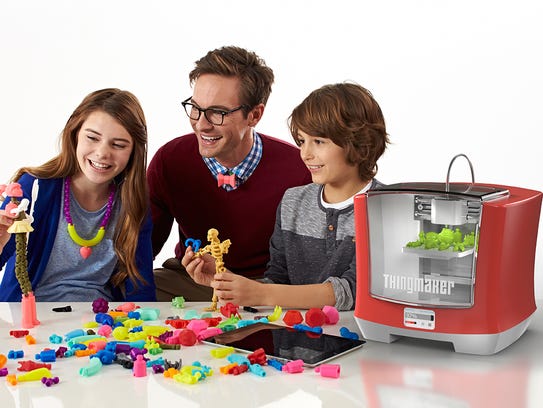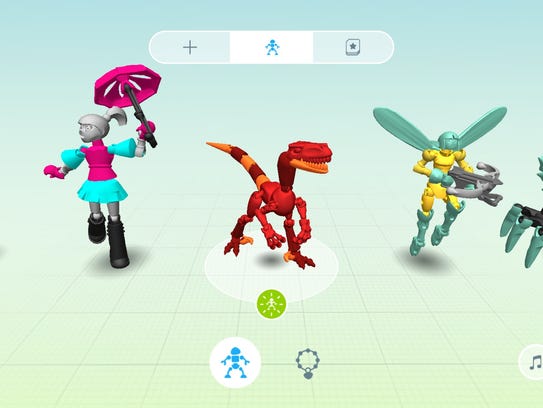Now Mattel, in collaboration with Autodesk, is about to resurrect ThingMaker as a $299.99, family-friendly 21st Century 3D printer. Mattel made the announcement in advance of the Toy Fair trade show kicking off here this weekend.
I saw a full-size, non-working replica of the printer, which works with a 3D printing app for iOS and Android. If not for its bold orange casing, you might mistake it for a funky-looking microwave oven.
Surrounding the replica were many of the plastic things you could print, including toy fairies, dolls, dinosaurs, robots, skeletons and jewelry. Consumers can custom design such objects inside a ThingMaker app, which supplies templates and a palette of drag and drop parts that you can assemble together on screen before you tap the print button. Parts are printed in batches. For safety purposes, the printer door automatically locks when printing starts.

Mattel's new 3D printer is due out in the fall. (Photo: Mattel)
“All the physical behaviors are as it would be when it was actually printed out, so you can get an idea for how it is going to mechanically move and what the limits of all the joints and sockets that you create are,” says Dan Pressman, creative director at Autodesk. You pick the colors for the objects in the app as well; come print time, you run separate jobs to print each batch of colors.

The Thingmaker app lets you design the objects you'll print. (Photo: USA TODAY)
The app is actually live now and can be used to design items for other standard 3D printers as well. But Mattel’s own new 3D printer isn’t coming out until the fall, even though you can preorder it on Amazon starting Monday.
“We’re going to use these seven months to really learn and gain analytics of how people are using it,” says Aslan Appleman, a senior director at Mattel.
For all their potential, and their use for industrial, professional, and hobbyist purposes, 3D printers have been slow to catch on in the home. Such printers have generally been too pricey, too slow and too complicated, and the motives for owning one — how many people want to print out a case for their smartphone — have eluded most consumers.
Mattel comes at it as a toymaker, of course, but the company is viewing its upcoming 3D printer more as a consumer electronics product than a toy per se. In fact, the printer is designed for users ages 13 and up. (The small parts you print out are rated as safe toys for 3 years olds and up.) Beyond Amazon, Mattel hasn’t finalized its distribution strategy.
Mattel has been tracking the evolution of 3D printing for awhile now. Appleman says, “We think this is the perfect time for us to come out in the market with a product that’s disruptive in our opinion.”

USA TODAY
View-Master rides Google Cardboard into virtual reality
It remains to be seen of course if ThingMaker can conjure up the same nostalgic appeal of other brands that Mattel has tried to reimagine with newer tech. It was almost a year ago to the day that Mattel teamed up with Google to produce a Google Cardboard-based version of the ViewMaster stereoscopic viewer.
Mattel’s printer will rely on standard PLA (Polylactic Acid) filament just like other 3D printers do. Mattel hasn’t announced the precise branded colors it may make available or pricing for the filament, but the printer is likely to come with at least one spool, and you’ll be able to use standard filament sold by third parties. (You can find spools online today for around $23.)
“Our thought is we want to make this open to makers,” Appleman says. “What we want to highlight is the ThinkMaker ecosystem.”
How much you can print off a single spool will vary by the size and type of objects that you choose to print. Rough estimate: with an average 1 kilogram spool of filament, you can print up to 20 figures, more than 30 jewelry items or about 100 rings.
No word yet on if or when you’ll be able to print Barbie or Hot Wheels or other famous Mattel toys. “Obviously we have quite a few iconic brands in our portfolio as well as access to partner brands. You can imagine that’s part of our longer term strategy,” Appleman says
Printing itself will not be a quick process. A small ring may take 30 minutes to print. A large toy could take 6 to 8 hours.
“We think it’s pretty magical to watch these things being printed but after awhile you don’t want to sit there for hours,” Appleman says. “For bigger prints, click print before (you) go to bed and wake up to a brand new toy"


